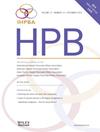肝外胆管癌术后监测期间 CA 19-9 升高的临床意义:基于提名图的短期复发预测方法。
IF 2.7
3区 医学
Q2 GASTROENTEROLOGY & HEPATOLOGY
引用次数: 0
摘要
背景:本研究旨在评估肝外胆管癌术后监测中碳水化合物抗原(CA 19-9)升高的意义,并确定短期复发的预测因素:本研究旨在评估碳水化合物抗原(CA)19-9 升高在肝外胆管癌术后监测中的意义,并确定短期复发预测因素:这项回顾性研究纳入了手术后CA 19-9升高的患者。根据 CA 19-9 升高时复发的检测结果,将患者分为 CT 阳性组和 CT 阴性组。CT 阴性组的短期复发定义为 6 个月内的复发。我们确定了短期复发的相关因素,并设计了一个预测提名图:在 190 例患者中,91 例(47.9%)肿瘤复发并伴有 CA 19-9 升高(CT 阳性组),99 例(52.1%)无复发(CT 阴性组)。在 CT 阴性组(n = 99)中,有 22 例(22.2%)在 6 个月内出现短期肿瘤复发。术前 CA 19-9(几率比 [OR]:1.5,P = 0.016)、术后 CA 19-9(OR:1.9,P = 0.047)、辅助治疗(OR:3.5,P = 0.032)和无炎症(OR:3.5,P = 0.045)是短期复发的预测因素。提名图的曲线下面积为 0.80(95 % CI:0.69-0.90):结论:尽管CA 19-9水平升高,但约50%的肝外胆管癌患者在术后监测期间没有复发。影响短期复发的因素包括术前和术后 CA 19-9、辅助治疗和炎症状态。本文章由计算机程序翻译,如有差异,请以英文原文为准。

Clinical significance of CA 19-9 elevation during postoperative surveillance for extrahepatic bile duct cancer: a nomogram-based approach for the prediction of short-term recurrence
Background
This study aimed to assess the significance of elevated carbohydrate antigen (CA) 19-9 in postoperative surveillance of extrahepatic bile duct cancer and to identify short-term recurrence predictors.
Methods
This retrospective study included patients with elevated CA 19-9 post-curative surgery. Patients were categorized into positive and negative CT groups based on the detection of recurrence at CA 19-9 elevation. Short-term recurrence was defined as recurrence within 6 months in the negative CT group. We identified the factors associated with short-term recurrence and devised a predictive nomogram.
Results
Among the 190 patients, 91 (47.9 %) exhibited tumor recurrence with CA 19-9 elevation (CT-positive group), whereas 99 (52.1 %) showed no recurrence (CT-negative group). In the CT-negative group (n = 99), 22 (22.2 %) experienced short-term tumor recurrence within 6 months. Preoperative CA 19-9 (odds ratio [OR]: 1.5, p = 0.016), postoperative CA 19-9 (OR: 1.9, p = 0.047), adjuvant treatment (OR: 3.5, p = 0.032), and the absence of inflammation (OR: 3.5, p = 0.045) were predictors of short-term recurrence. The area under the curve of the nomogram was 0.80 (95 % CI: 0.69–0.90).
Conclusion
Despite elevated CA 19-9 levels, approximately 50 % of patients exhibited no recurrence during postoperative surveillance for extrahepatic bile duct cancer. Factors influencing short-term recurrence encompass pre- and postoperative CA 19-9, adjuvant treatment, and inflammatory status.
求助全文
通过发布文献求助,成功后即可免费获取论文全文。
去求助
来源期刊

Hpb
GASTROENTEROLOGY & HEPATOLOGY-SURGERY
CiteScore
5.60
自引率
3.40%
发文量
244
审稿时长
57 days
期刊介绍:
HPB is an international forum for clinical, scientific and educational communication.
Twelve issues a year bring the reader leading articles, expert reviews, original articles, images, editorials, and reader correspondence encompassing all aspects of benign and malignant hepatobiliary disease and its management. HPB features relevant aspects of clinical and translational research and practice.
Specific areas of interest include HPB diseases encountered globally by clinical practitioners in this specialist field of gastrointestinal surgery. The journal addresses the challenges faced in the management of cancer involving the liver, biliary system and pancreas. While surgical oncology represents a large part of HPB practice, submission of manuscripts relating to liver and pancreas transplantation, the treatment of benign conditions such as acute and chronic pancreatitis, and those relating to hepatobiliary infection and inflammation are also welcomed. There will be a focus on developing a multidisciplinary approach to diagnosis and treatment with endoscopic and laparoscopic approaches, radiological interventions and surgical techniques being strongly represented. HPB welcomes submission of manuscripts in all these areas and in scientific focused research that has clear clinical relevance to HPB surgical practice.
HPB aims to help its readers - surgeons, physicians, radiologists and basic scientists - to develop their knowledge and practice. HPB will be of interest to specialists involved in the management of hepatobiliary and pancreatic disease however will also inform those working in related fields.
Abstracted and Indexed in:
MEDLINE®
EMBASE
PubMed
Science Citation Index Expanded
Academic Search (EBSCO)
HPB is owned by the International Hepato-Pancreato-Biliary Association (IHPBA) and is also the official Journal of the American Hepato-Pancreato-Biliary Association (AHPBA), the Asian-Pacific Hepato Pancreatic Biliary Association (A-PHPBA) and the European-African Hepato-Pancreatic Biliary Association (E-AHPBA).
 求助内容:
求助内容: 应助结果提醒方式:
应助结果提醒方式:


